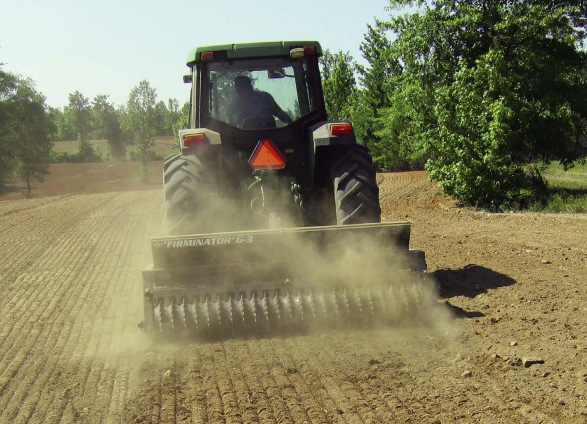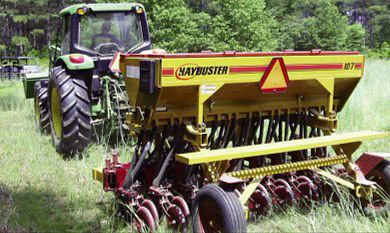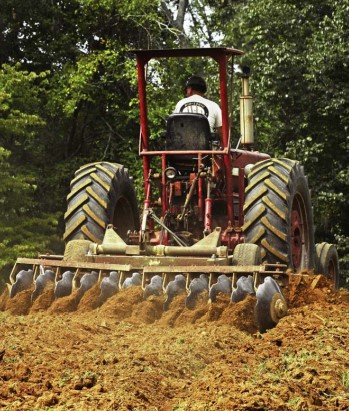Colin Williams, USDA, Natural Resource Conservation Service | Originally published in GameKeepers: Farming for Wildlife Magazine. To subscribe, click here.

Have you ever looked across the fields on your farm and wondered how the soil formed under native prairies, forests and wetland vegetation? And, over those centuries, how the land not only sustained abundant vegetation and diverse species of wildlife but kept the waters clear and pure? Perhaps, but with most people these thoughts rarely come to mind. That same landscape which not only sustained all things living on and in the soil now requires an ever-increasing amount of a farmer’s time and money to both maintain productivity and produce a cultivated crop.
Why is that? Native soils are covered with a layer of plant litter and/or diverse growing plants throughout the year and are tilled by soil organisms, not by machinery. Beneath the surface litter layer, a rich and diverse complexity of soil organisms decompose plant residue and dead roots and release their stored nutrients slowly over time. Organisms living in the soil, such as earthworms, arthropods, fungi, and nematodes, then release these bound-up minerals and convert them into available resources necessary for plant growth. Therefore, these native landscapes create their own fertilizer which is naturally and continuously recycled, essentially never leaving the site.

benefit the soil and future crops - like suppressing
weeds, adding nutrients or breaking compacted
soils.
Cultivated fields and bare soil disrupts and even destroys the natural soil ecosystem. In a bare soil environment, the soil is in effect in “starvation mode” with no live roots supplying carbon into the soil. Because of the lack of carbon in bare soils, essential macro and microorganisms lose an essential food source which then means little, if any, microbial activity. The bare ground also increases soil temperature, up to 115 degrees, making the soil less hospitable to soil organisms. A soil ecosystem does not function without the energy from the sun, the water cycle, the bio-community cycle, the carbon cycle, and nutrient cycles all working in concert. Tillage disrupts these cycles and is hampered in soil ecosystems with no plants covering them. Understanding how soil ecosystem processes work together is a key factor in improving soil health.
Assessing Soil Condition
Observing the soil in your field is a great place to start when considering soil health. There are signs of poor soil health you may recognize as part of the normal process of growing crops. Such questions you may ask yourself are: Are yields declining? Do my crops perform less well than my neighbor’s crops on similar soil types? Are there any symptoms of nutrient deficiency? Is the soil obviously compacted, or does it plow up cloddy and take secondary tillage practices to prepare the seed bed? Does the soil crust easily, or are there visible signs of erosion? Does it take more power than it used to when running tillage equipment? Are there increased problems with weeds, disease, or pest issues? If you answered yes to any of these questions, you may want to critically evaluate your operation with other soil health assessment tools to get to the root cause of the problems you are observing.
Another way to analyze soil health in your fields is through the use of field indicators. Such indicators include the crusting, ponding, runoff, and erosion observations for a field either during or after a rainstorm. A crust occurs when raindrop impact dislodges soil particles and breaks aggregates. Upon drying, the soil then clogs surface pores which results in a hard crust. Areas that crusted will typically crack when the soil dries.
Ponding can be visible for hours or even days after a storm. Sheet and rill erosion can be observed, and if a gully is observed you may have major soil health problems. Soil tilth and hardness are also easy to measure quantitatively in the field. Is the soil friable, or hard to break apart? While most soil organisms are difficult to see without the naked eye, earthworms are an easy organism to count. Take a spade full of soil and count how many worms are in your soil. Healthy soil should have about 10 worms per square foot of soil. You can also dig up the roots of plants and observe what they look like. When looking at roots, make sure to dig deep enough to get through the plow pan. Are they branched and extending in all directions? Or, are they fine or frail and growing in one direction? Do they hang onto aggregates of soil when you shake the roots? Do you observe roots that have gone deeper than the plow pan or are they impeded?
And finally, look for nutrient deficiency symptoms in your fields. Soil health problems are most easily observed during extreme weather conditions. Walk the field after a rainstorm or during a dry spell. What differences do you see in your inspections? Using simple field indicators lets you record the health of your soils through time. By taking the time to assess your soil you can easily determine soil quality and soil health. A healthy soil will ultimately be more productive, more efficient and more sustainable than a starving soil.
Take another look at those natural areas of your properties. Is plant life diversified or is there a monoculture? I believe you will find these natural ecosystems, such as the soil ecosystem, are diversified. Managing for healthy soil, or improved soil function, by creating a natural soil ecosystem includes four main factors:
1. Manage soils more by disturbing them less
2. Keep the soil covered as much as possible
3. Keep plants growing throughout as much of the year as possible to feed soil organisms 4. Diversify as much as possible using crop rotation and cover crops.
Managing Soil by Disturbing Less
Agricultural soil disturbance includes physical, chemical and biological disturbances. Physical disturbance, or tillage, destroys the habitat for soil organisms and destroys soil structure. Chemical disturbance-through pesticides, fertilizers, and other amendments simplify the soil system and biological disturbances can be viewed as a lack of plant diversity or lack of food and cover for soil organisms.

from the sun, the water cycle, the bio-community cycle,
the carbon cycle and nutrient cycles all working in
concert. Tillage disrupts these cycles. The use of a no-till
planter means the soil will stay covered all of the time.
Tillage or physical disturbance impacts the bio-community cycle both below and on top of the surface. The bio-community needs habitat for the soil microbes, arthropods, plants, and other animals to function correctly; all these living creatures are set back by tillage. Tillage not only leaves the soil bare, prone to erosion, crusting, and drying, it makes carbon sources unavailable to the greatest number of species. The greatest populations of microorganisms are near the soil surface near living plant roots. Placing crop residues below this very active zone puts them out of reach of many organisms that will decompose the residue and cycle the nutrients. Continuous pummeling of the soil surface exposes more organic matter to decomposition by breaking aggregates that hold organic matter. Tillage can also create both a hard pan and soil compaction which restricts root and water movement in the soil. Tillage is a slippery slope and hard to break away from. Most of the problems we view that we are “fixing” with tillage are actually caused by tillage.
Another common practice that results in reduced soil health and water quality is poor nutrient management or chemical disturbances. Poor nutrient management can be caused by the wrong amount, placement, form, and timing of nutrients. It’s easy to see a yield increase when fertilizers are applied since yields are the only portion being studied, but what are these applications doing to the natural soil ecosystem?

and must turn the soil using conventional means,
but getting the soil covered again with a crop as
soon as possible and practicing sound crop rotation
is important.
Humans have an innate nature to control our environment, so tools, such as tillage and chemical disturbances fit perfectly in this. Edward Faulkner, in his 1943 book, The Plowman’s Folly writes “the fact is that no one has ever advanced a scientific reason for plowing.” And he couldn’t be more right. Farming in nature’s image—which is low disturbance, high diversity—is the key to healthy soils.
Keeping the Soil Covered
If improving soil health is your goal, you should not really see the soil very often. Soil should always be covered, or “armored,” by growing plants and/or their residues. This cover conserves moisture, intercepts raindrops to protect erosion, suppresses weed growth and provides necessary habitat for inhabitants of the soil food web. Keeping the soil covered allows crop residues to decompose and cycle nutrients back into the topsoil. The topsoil is the most important biologically active part of the soil, yet it is the most susceptible to wind and rain erosion when left unprotected.
Keep Plants Growing Throughout as much of the Year as Possible
Healthy soil is dependent upon how well the soil food web is fed. The soil food web is a complex association of organisms cycling nutrients throughout the soil. While there are many sources of food in the soil, there is no better food than the sugars released by living roots. Soil organisms feed on sugar from living plant roots first. Next, they feed on dead plant roots, followed by above ground crop residues and finally the organic matter in the soil. Providing soil organisms plenty of easily accessible food helps to ensure the cycling of nutrients plants need to grow.
Diversify with Crop Diversity
This guiding soil health principle prescribes diversity above ground in plant life which then equals diversity below ground in the soil food web. Growing a diverse rotation of crops is fundamental to increasing the diversity in the soil food web. Lack of biodiversity limits the potential of any cropping system. Disease and pest problems increase as yields and profitability decrease. Increasing the diversity of crop rotation while utilizing various types and mixtures of cover crops increases soil health, and soil function reduces your input costs and increases profitability.
Managing your farmed acreages for soil health utilizing the four main soil health principles will ultimately improve wildlife habitat through a variety of different ways. These principles focus on keeping the soil covered and the food soil web-fed with crop residues and growing plants. Growing plants provide a food source for micro and macro-organisms below the soil surface and diverse wildlife above the ground. Plants may be natural food sources or introduced crops. Diversifying crops provides food sources for living organisms throughout the year. Couple that with the use of cover crops of legumes, grasses, forbs, and brassicas varies food sources and food source availability all that much more.
Growing plants and residues provide vital nesting, brood rearing; food source and winter cover for game and nongame bird species. The steps made in improving soil health can turn those post-harvest wildlife deserts to key areas of food source and habitat for wildlife on your farm, while also improving farm profitability.
Living organisms (those we can see and those we cannot) all have common requirements: a source of food; and a comfortable place to dwell. With that, all will thrive in a food web that does link all living creatures. Stated in another way – if you build it, they will come. If healthy and sustainable populations of wildlife are your goal, develop the foundation of all life on the land, your soil. And utilize the four principles of soil health to accomplish your goal!































